The voltage in the mains is rarely a stable value of 220 volts, most often it walks with an acceptable value of plus or minus 10%. Household and computer equipment copes with the value of 200 or 240 Volts, but in the event of a jump, even if it is a short one, the equipment will most likely fail.
What are power surges and why are they dangerous?
First of all, voltage drops occur in typical apartment buildings. Power is supplied through three phases and with the help of switchboard current enters each apartment through one working phase and a neutral wire. It is important to note that “zero” experiences the greatest load and, what is bad, it is common for everyone. Accordingly, when residents turn on a lot household appliances at the same time - the power grid is experiencing an overload. A frequent occurrence is the burnout of the neutral wire at the base in the shield. Moreover, at this moment, neighboring apartments become connected in phase and the voltage can jump to 380 volts, which will inevitably lead to the failure of those devices that do not have sufficient protection.
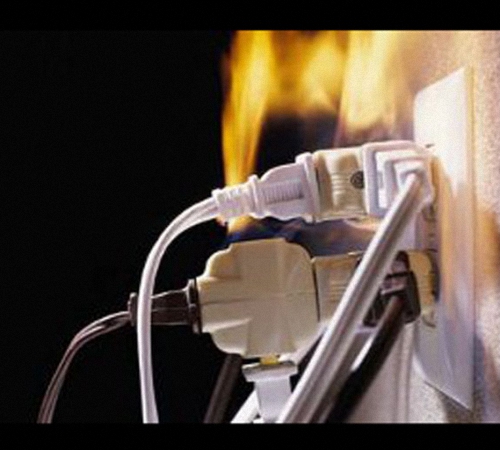
There are many reasons that can lead to such a situation, but what is characteristic is that they have a common source. Substations that distribute electricity are often morally and technically obsolete, and even though the equipment is maintained in working order, the question of replacing it has often not been raised for decades. The number of household electrical appliances is constantly growing, and, accordingly, the load on substations is increasing. Given the fact that at the time of their construction, the reserve was calculated at a rate of 4.5 kW, the energy consumption at that time and now is a significant difference.
The condition of the electrical wiring also leaves much to be desired. In addition, the situation with unfortunate repairmen who are able to connect to common system working electric welding, which will significantly increase the load on the power grid, which will cause other people to have an overload situation on the shield. Well, if in this case installed protective equipment, but if they are not there and there was hope for the eternal "maybe" - then the situation with the replacement of the burnt household appliances and a noticeable gap in the budget is extremely high. Fortunately, there are a large number of the most diverse equipment on the market, designed to protect equipment from power surges as much as possible.
What are the main means available to protect equipment from power surges
It is difficult for an unprepared person to understand the types of devices and their purposes, therefore, before buying, it is important to study the theory in order to have an idea of what exactly needs to be purchased. Modern devices are divided into several types:
- protective relays,
- step down transformers,
- step up transformers
- Surge Protectors,
- multifunctional protection devices,
- circuit breakers,
- network filters.
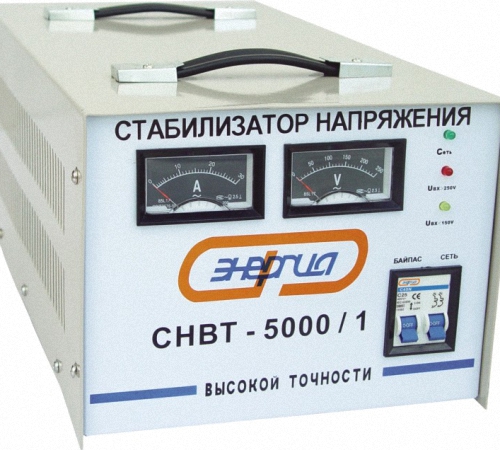
It is worth considering in more detail the purpose and capabilities of each device in order to have a good idea of the overall picture of providing protection against voltage surges.
Safety relay
It is an automatic device that is triggered when it is exposed to voltage drops in the network. It disables electrical circuit from the network in the event that the control microcontroller registers an increase in voltage indicators compared to the established normalized ones. The load is automatically connected back to the circuit when the voltage readings return to normal.

Its value is set by the user independently, with the help of the control system, and in the future the controller is guided by this value. Since the relay is not capable of withstanding loads over 8 kW, while indicators for apartments sometimes reach 25 kW, a protective relay is used in tandem with a circuit breaker, which serves as the main protection.
A good example of such a device is the VP-16AN relay from the DigiTop manufacturer, which is essentially a custom adapter that can protect a directly connected electrical appliance from short circuit and overload. The cost of such a device is at the level of $12.
step-down and step-up transformer
The main purpose of transformers, which are static converters electrical energy, consists in changing the voltage alternating current. These devices operate under the condition AC voltage and have several inductive windings connected to each other. Depending on the ratio of the voltage to the current, transformers are divided into step-up and step-down:
- In a step-up, the primary winding is characterized by low voltage and fewer turns, while the secondary, on the contrary, is high. As the name implies, this device increases the voltage and is used to transmit electricity over long distances.
- In a step-down, on the contrary, the primary winding shows a high voltage and more turns, and the secondary is low. Transformers of this type are used to distribute incoming electricity to consumers.
Tellingly, a transformer of any type is used both step-down and step-up when they are started by applying voltage in the opposite direction. In this case, the down will become up, and vice versa.
According to their design, transformers are divided into two types:
- oil,
- dry.
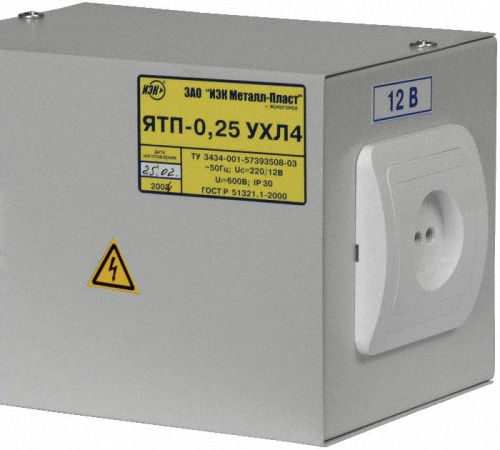
The first type has a tank in which transformer oil is located. It serves as a good insulator and at the same time a coolant for the magnetic circuit with windings. As a rule, these types are more often used in substations.
Dry transformers have passive air cooling and are installed in residential premises and industrial facilities. Air-cooling avoids the oil tank leak problem, but is less efficient.
Roughly speaking, a step-down transformer is necessary in order for 220 Volts to come into the house, taking into account the error. It is unacceptable to immediately supply the consumer with high voltage from the substation, and therefore a transformer serves for these purposes.
Step-down transformers for domestic purposes do not have a high price. The cost of the YaTP-025 model, which is capable of lowering the input value from 220 to 12 volts, is $30, the model that is able to lower the input value of 380 to 220 will cost more, on average, from $130
Voltage regulator
This device is designed to maintain a certain level of output voltage. The operation of the stabilizer helps protect equipment from unstable power supply and interference, as well as network failures.
Such equipment is used when it makes sense to protect household electrical appliances and computer equipment from drops and power surges. In case of their occurrence, the stabilizer will turn off the internal network and the devices connected to it until the voltage value returns to normal.
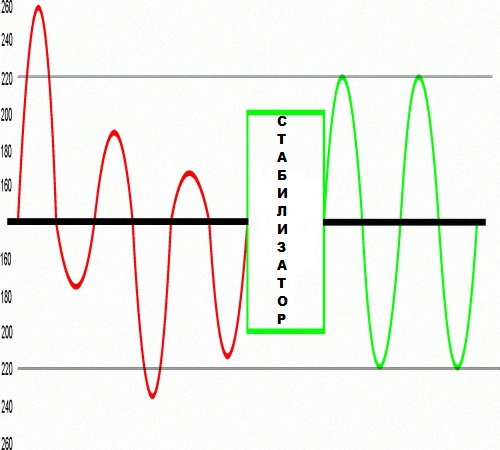
The use of stabilizers allows you to get certain advantages:
- surge and surge protection,
- elimination of electromagnetic interference,
- short circuit protection,
- protection of telephone lines from breaks and noise on the line,
- more low price compared to other protective equipment.
Modern AC voltage stabilizers, which are used in everyday life, are conventionally divided into the following varieties:
- mechanical with servo drive,
- electronic,
- relay,
- hybrid,
- compensatory,
Models are produced in two versions: single-phase and three-phase, the power is the most diverse - from hundreds of watts to several megawatts. An important distinguishing feature of a high-quality stabilizer will be its speed at changing the voltage level. As a rule, the response occurs within a few milliseconds. The second important factor in the operation of the stabilizer is its accuracy of the output voltage. The value must not fluctuate more than 10% of the nominal value.
Optimal in choosing models of stabilizers that can withstand tenfold overloads, and for which there is no need to calculate the power reserve.
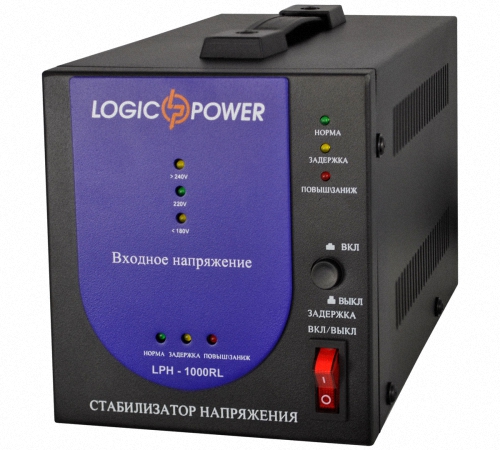
Multifunctional protection device
First of all, this device is designed to turn off the equipment in the event that the mains voltage has gone beyond the permissible values of the minimum indicator of 160 V or the maximum of 280. The device consists of a magnetic relay and voltage control combined with each other. A protective varistor is also connected to them, which, in the event of high-voltage impulses in the network, shunts them to a set safe value. A feature of this device is the mode of operation and the actions that the device produces:
- In the event of an increase in voltage and beyond the permissible limits, the power is turned off. At the same time, a timer is started, which counts down the reclosing time. In the event that another jump occurs while waiting, the timer is reset and the countdown starts again.
- In the event of a low power supply, the protection device starts counting the trip delay. In the event that after the expiration of the time the voltage level does not return to normal, a shutdown will occur, but if the decrease was short-term, the device will continue to control the load level.
Such a solution allows you to provide good protection against the effects of impulses, as well as control the quality of the voltage supplied to the connected equipment.
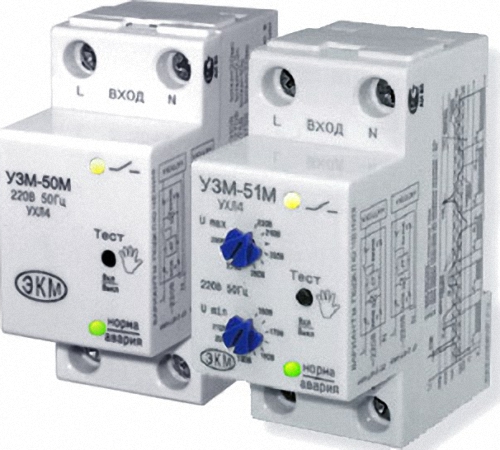
It is important to remember that UZM is not capable of replacing other means of protection, therefore it is more often used as a comprehensive solution to the problem.
Circuit breakers
These are one of the most common types of solutions for protecting an apartment or office space from power surges. The switch, which is also called the "automatic", controls the current strength in the circuit, while preventing the occurrence of overcurrents, the strength of which exceeds the value allowed for wiring. As a rule, they work when an excessive load is connected to the network, or in the event of a short circuit.
The device works thanks to the releases used in its design, which are of two types:
- thermal,
- electromagnetic.
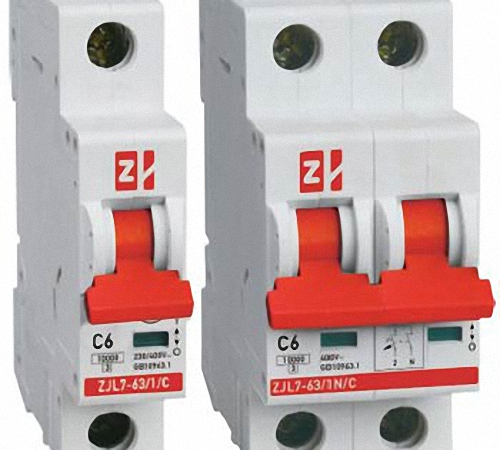
Thermal ones consist of a bimetallic plate that clearly responds to changes in the current flowing through it. With excessive heating, the plate releases a special spring, which turns off the machine.
Electromagnetic has the same principle of operation, with the only difference being that a coil with a magnetic core is used, which, when the load is exceeded, releases the spring.
It is best to use automatic machines in combination with a residual current device, which also controls the leakage current. The RCD is also protected by the machine and is always installed after the safety switch. Such a combination is called a differential automaton. The benefit of installing the device is a simpler installation scheme and space savings in the switchboard.
Network filters
These devices are an extension cord with a large number of outlets and a power button. In fact, it is more often used as an extension cable and a place to connect personal computer. Due to the presence of a varistor, the mains filter is able to protect the electrical equipment included in it and suppress high-frequency interference.
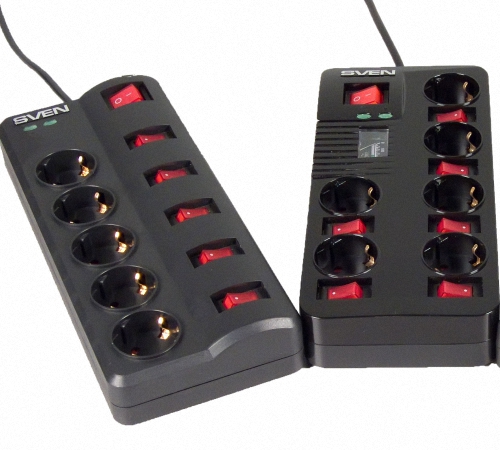
In the event of a high-frequency pulse, the resistance of the varistor drops, due to which the excess electrical pulse is converted into heat. Such a solution will provide additional protection for equipment, but you should not rely too much on a surge protector. It is advisable to purchase it primarily as an extension cable; to ensure the safety of equipment, it is necessary to pay attention to full-fledged protection devices.
Uninterruptible power supplies
Such devices are used primarily for those devices on which a sudden power outage can harm the operations performed, that is, computers. This equipment is designed to provide uninterruptible power supply, while thanks to the built-in battery, they are able to provide computer work from one minute to several hours.
First of all, they are purchased in order to “gain time” in case of a sudden power outage, which will allow you to save all the necessary data and operations on your computer. The internal structure of uninterruptible power supplies is similar to stabilizers, the difference is visible only in the presence of a lead battery.
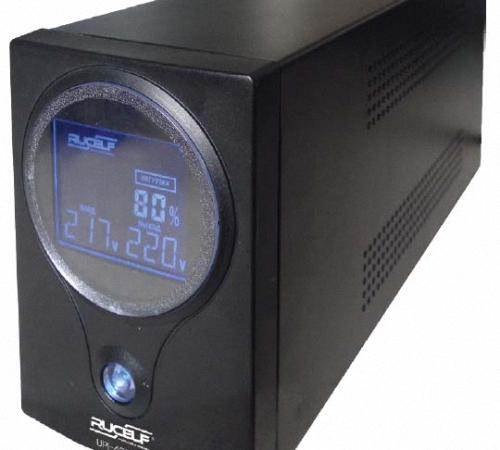
Nevertheless, experts recommend buying a UPS if you need to save data, otherwise they are inferior to stabilizers. The main disadvantage of most UPS is switching on at low voltage and insufficient sensitivity at high voltage. In addition, the device cannot be left unattended, so when you stop working at the computer, it must also be turned off. At the same time, the price of a stabilizer and an uninterruptible power supply of the same power has a difference several times in favor of the first - so the choice is obvious. To save information and safely turn off the computer, even budget models priced from $45 are enough, the operating time of which is estimated at an average of 15 minutes - which is quite enough for the correct completion of the work.
It's not a secret for anyone that voltage drops that occur from time to time in our energy network can disable almost all household appliances in a matter of seconds. Thin electronics are not designed to work with high or low voltage, and if it is still somehow ready to put up with the latter, then voltage surges in the big direction kill it in the truest sense of the word. How to deal with power surges and how to protect expensive home appliances from their harmful effects?
There are not so many devices capable of providing high-quality protection of home consumers from power surges - in fact, there are only two of them. This is a relay-breaker and. One way or another, they definitely cope with the duties assigned to them. But first things first, and first consider the question of what constitutes a surge protection relay.
photo surge protection
Surge Protection: Breaker Relay
The principle of operation of this device is quite simple - when the voltage in the household electrical network increases or decreases, the relay is activated and completely de-energizes the wiring. After a forced shutdown, the breaker relay electronics check the network for voltage stability every few seconds and, if it is within tolerance, the device automatically resumes the supply of electricity.
This principle of operation characterizes the main disadvantage of this device. As a rule, voltage fluctuations in our network can occur for quite a long time - as a result, the consumer either remains without an energy source for a long time, or works with frequent interruptions, which also does not reflect very well on his performance. Such a surge protection device can be called a crude solution to this problem - although you save, for example, the same heating boiler from momentary "death", you significantly reduce its service life.
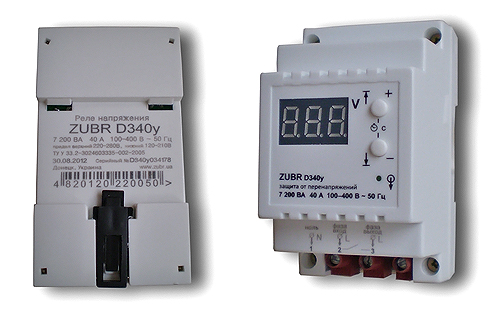
Surge protection relay photo
The breaker relay is quite simple to use - it has only two control buttons on the front panel, with which you can adjust the upper and lower limits of the allowable voltage, as well as a small screen for displaying status information. electrical network. The process of setting up this device is also not difficult - a long press of the buttons allows the device to switch to the setting mode, and a subsequent short press on them ensures that the voltage limits are set.
Modern industry produces two such types of surge protection devices - one is intended for local use and is plugged into an outlet, and the second is used for global protection of all domestic electricity consumers and is installed directly in. It is difficult to overestimate the advantages of the latter, just like its disadvantages. In the event of an unstable operation of the energy network, the entire apartment or house remains immediately without a power source. In this regard, the work of the voltage stabilizer looks much more attractive.

Surge protection device
Surge Protection Device: Stabilizer
If we talk about the principle of operation of this device, then such a complex and stuffed with electronics device as an automatic voltage stabilizer compares favorably with the protection described above. It does not turn off the power supply, but, so to speak, equalizes the voltage, turning it from a very high or low voltage into a current suitable for household electrical appliances.

Wall voltage stabilizer photo
Modern industry produces several types of voltage stabilizers - their main difference lies in power. Some (simple voltage stabilizers) allow you to use them for one or more consumers, while others (more complex) are designed to protect all apartment or home electricity consumers.
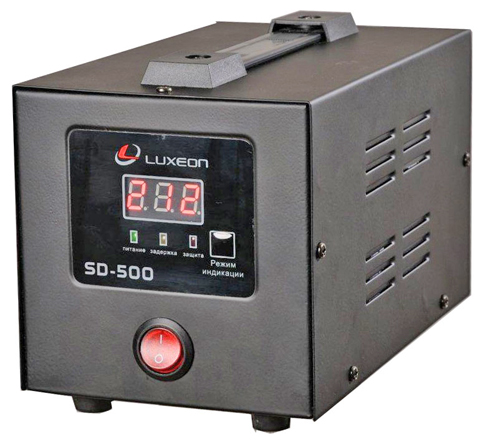
Automatic Voltage Stabilizer
When choosing a stabilizer for a house or apartment, you should pay attention to the following operating parameters:
- Number of phases - used when heavy loads in homes with a large number of consumers. With its help, electrical appliances are connected to two different phases (for example, lighting on one phase, and sockets on the other).
- Output power - it all depends on the load on the electrical circuit.
- Input voltage range - the larger the drops, the wider the input operating voltage range should be, respectively.
- Stabilization accuracy - stable voltage always favorably affects the operation of most electrical appliances.
- Performance - as a rule, almost all modern voltage stabilizers have this characteristic at their best.
- Weight and dimensions - here you really need to proceed from the place where the stabilizer is installed. If you look at this indicator from the technical side, then, as a rule, large and massive stabilizers turn out to be much better.
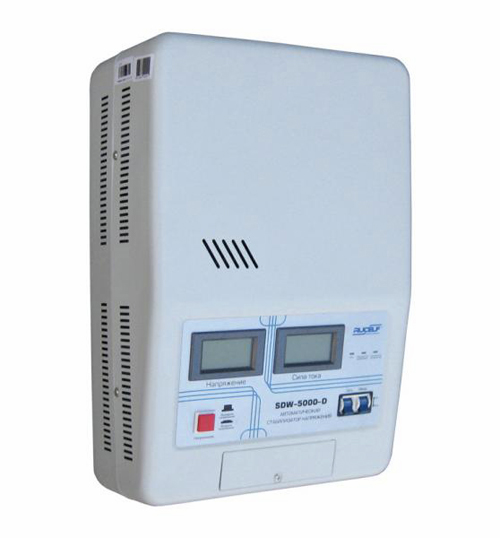
photo surge protection device
How to connect devices from power surges
Both the relay-breaker and the stabilizer of any power are connected to the electrical network in almost the same way. For connecting cables, they are equipped with special terminals. Depending on the model, they can have either four or six terminals - two or three of them are for input voltage and the same number for output stabilized electric current.

Connecting devices from power surges
When connecting these surge protection devices, it should be understood that they must be included in the home or apartment circuit immediately after the input circuit breaker and protected by a differential relay ().
Like all electrical devices, majority powerful stabilizers voltages provide for their connection to a protective system, through which these devices dump excess voltage without all sorts of serious consequences. In general, the role of protective grounding in the fight against voltage surges is difficult to overestimate - it just so happened that these two devices are connected to each other and perform an almost identical function.
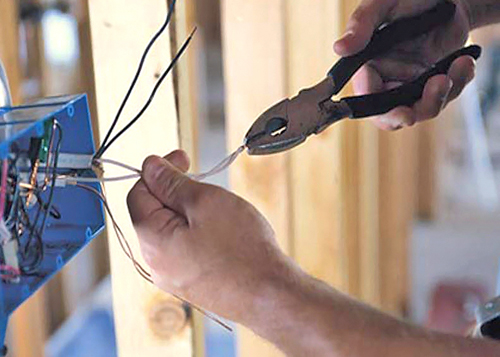
How to connect a voltage stabilizer photo
In general, protection against power surges today is a problem, moreover, a very urgent one, and it needs to be solved. It is better to install protection at the repair stage - in this case, without any special damage and any alterations to the electrical wiring, you can qualitatively withstand almost all drops in the electrical network.
Author of the article Dmitry Vorokhov
At present, the issue of a stable voltage value of the power grid is quite acute. Network organizations they are in no hurry to reconstruct and modernize power lines, substations and transformers. In the meantime, the situation is only getting worse, so voltage fluctuations in our networks are quite common.
According to GOST 29322-92 voltage in the power grid of our country should be within 230 V in one phase and 400 V between phases. But if you live in a rural area or close to a city, then problems with constant value voltages are very high, and this should not be ruled out in the city itself, especially in the old housing stock. Voltage fluctuations are very detrimental to electrical appliances in the house. For example, due to low voltage, a refrigerator or air conditioner may burn out (the compressor will not start and overheat), the power of the microwave oven is greatly reduced, and incandescent lamps shine dimly. Well, high voltage will simply “kill” your household appliances. I'm sure many of you have heard of "burning out zero" in high-rise buildings, and how entire entrances are carried to workshops to repair household appliances.
The causes of voltage fluctuations in the network are different:
- Closing one of the phases to neutral, as a result, there will be 380 volts in the outlet;
- Burn-out (break) of zero, if you have a low load at this time, then the voltage will also tend to 380 V;
- Uneven load distribution over the phases (skew), as a result, the voltage decreases in the most loaded phase, and if a refrigerator and air conditioners are connected to it, then there is a high probability that they will break;
An example of a video showing the operation of a voltage relay
To solve the problem of power surges in networks, special devices help - voltage monitoring relays. The principle of operation of such relays is quite simple, there is " the electronic unit", which monitors that the voltage is within the limits set by the settings and, in case of deviations, signals the release (power unit), which turns off the network. All household voltage control relays turn on automatically after a certain time. For ordinary consumers, a delay of a few seconds is sufficient, but for refrigerators and air conditioners with compressors need a delay of several minutes.
Voltage control relays are single-phase and three-phase. Single-phase voltage relays disconnect one phase, and three-phase - simultaneously all three phases. At three-phase connection in everyday life, single-phase voltage relays should be used so that voltage fluctuations in one phase do not lead to disconnection of other phases. Three-phase voltage relays are used to protect motors and other three-phase consumers.
I divide surge protection devices into three types: UZM-51M from Meander, Zubr from Electronics and all the rest. I do not impose anything on anyone - this is my personal opinion.
Voltage relay Zubr (Rbuz)
This device is designed to protect against voltage surges (zero burnout). BISON is produced in Donetsk.

I will note the features of this voltage relay.
Voltage indication on the device - shows the voltage value in real time. This is quite convenient and necessary to assess the situation with the voltage in the network. The error of indications is low, the difference relative to the high-precision Fluke 87 multimeter is only 1-2 Volts.

Zubr voltage relays are produced for various rated currents: 25, 32, 40, 50 and 63A. The device at a rated current of 63A can withstand a current of 80A for 10 minutes.
The upper voltage value is set from 220 to 280 V in increments of 1 Volt, the lower value is from 120 to 210 V. The re-closing time is from 3 to 600 seconds, in increments of 3 seconds.
I put on the Zubr voltage relay, the maximum (upper) voltage value is 250 Volts, and the lower value is 190 Volts.
For devices with an index t in the name, for example Zubr D63 t, there is thermal protection against internal overheating. Those. when the temperature of the device itself rises to 80 degrees (for example, due to heating of the contacts), it turns off.
The Zubr voltage relay occupies 3 modules or 53 mm on a DIN rail and is only single-phase.
The passport and the above diagrams for connecting the Zubr voltage relay do not say about current limits, but in the old documentation, it was previously indicated that no more than 0.75 of the nominal.
Zubr voltage relay wiring diagram

Currently, manufacturers claim that the relay can be connected at face value. If the value of the Zubr is less than the value of the introductory machine, then it is necessary to use a voltage relay in the connection circuit - a contactor.
relay warranty Zubr voltage the manufacturer gives whole 5 years! Has a very good feedback from colleagues - members of the forum. And just like Meander, there is a Zubra representative on the MasterCity forum who is not afraid to communicate in public. And by the way, it is significant on the example of UZM and Zubr that representatives of manufacturers of quality products are not afraid to communicate on forums.
Zubr Voltage Relay Video
Update (07.06.15). Currently, the Zubr voltage relay is sold in Russia under a different name Rbuz (the word Zubr is the opposite).
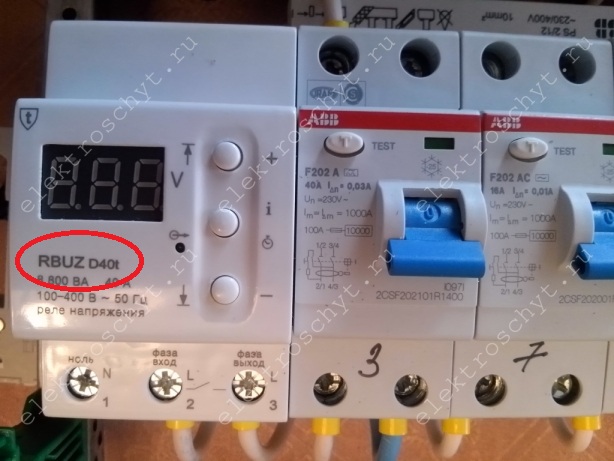
This is due to the fact that in Russia the Zubr trademark is registered for another manufacturer and only the name of the relay has changed, while all components have remained the same.
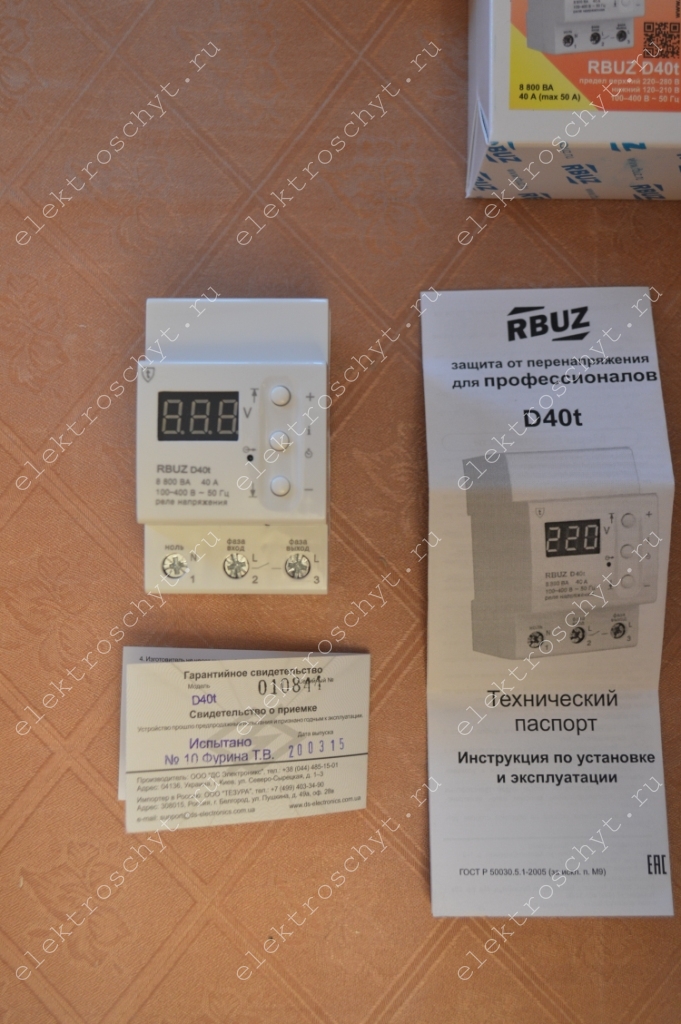
 .
.
UZM-51M. The protection device is multifunctional.
At present, the UZM-51M has proven itself to be reliable and easy to connect.

UZM-51M is designed for current up to 63A, it occupies 2 modules on a DIN rail (width 35 mm). With a standard version, the operating temperature of the UZM is from -20 to +55 degrees, so I do not recommend installing it in a shield on the street. True, there are also from -40 to +55, but I have not seen such on sale, if only to contact Meander CJSC directly.The maximum setting for the upper voltage shutdown is 290 V, the lower threshold is 100 V. The re-closing time is set independently - it is either 10 seconds or 6 minutes. Can be used in networks with any type of grounding: TN-C, TN-S, TT or TN-C-S.
Wiring diagram UZM-51M
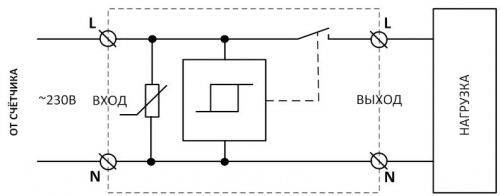
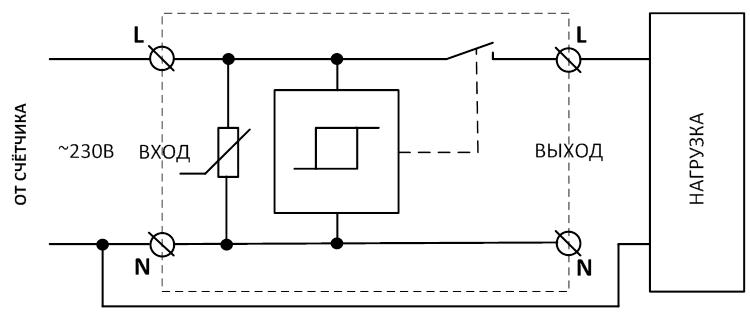
Meander produces two more types of single-phase voltage relays - these are UZM-50M and UZM-16. The main difference between the UZM-50M and the UZM-51M, perhaps, is only that, as we know, the latter, as we know, can be set to operate independently, and in the UZM-50M the setting is "hard", according to the upper voltage limit - 265 V, and according to lower - 170 V.
UZM-16 is designed for a current of 16A, so it is placed only on a separate electrical receiver. For example, in order not to wait 6 minutes until the UZM-51 turns on, the refrigerator can be connected via the UZM-16, on which the turn-on delay is set to 6 minutes, and on the main UZM-51M to 10 seconds.
I set the maximum (upper) voltage value of 250 Volts on the UZM-51M, and the lower value is 180 Volts.
Meander also produces a three-phase voltage relay UZM-3-63, as I wrote above, such relays are used mainly to protect motors.
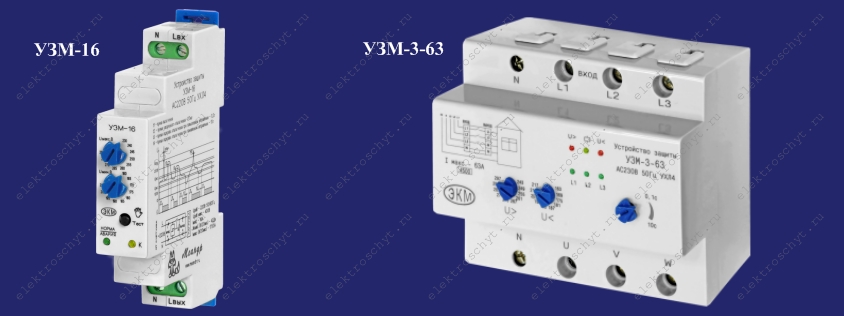
Good reliable surge protection. The UZM does not need to be connected with a contactor, as is usually done with other voltage relays. The device is made in Russia. Warranty for UZM 2 years. Most importantly, Meander's representative is present at the most popular Mastercity forum, he always advises on products, and is also attentive to the comments of forum users, whose comments at one time helped improve the UZM-51M.
Installation example of UZM-51M in a three-phase switchboard for country house, where USMs are installed in each phase.

Perhaps one drawback in the UZM-51M relative to other voltage relays is the lack of voltage indication. But the difference in price between the UZM and the voltage relay with a contactor allows you to buy and install a voltmeter separately.
Voltage relay RN-111, RN-111M, RN-113 from Novatek
These voltage relays are produced in Russia. As you can see from the title, three types of voltage relays can be purchased from Novatek.
The RN-111 and RN-111M are practically the same device in terms of parameters, the main difference between them is that the RN-111M relay has a voltage indication, while the RN-111 does not.
The upper voltage limit is from 230 to 280 V, the lower limit is from 160 to 220 V. The automatic restart time is from 5 to 900 sec. These relays have a 3 year warranty.
Connection diagram for voltage relay RN-111
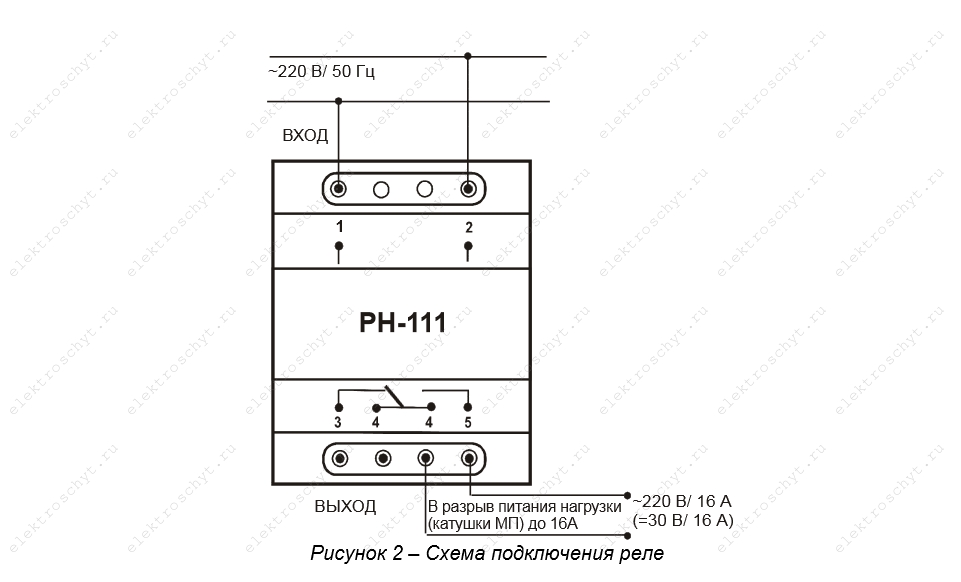
RN-111 are designed for small currents up to 16A or power up to 3.5 kW, but to connect a higher load, RN-111 can be switched on together with contactors (magnetic starters).
Voltage relay connection diagram with contactor
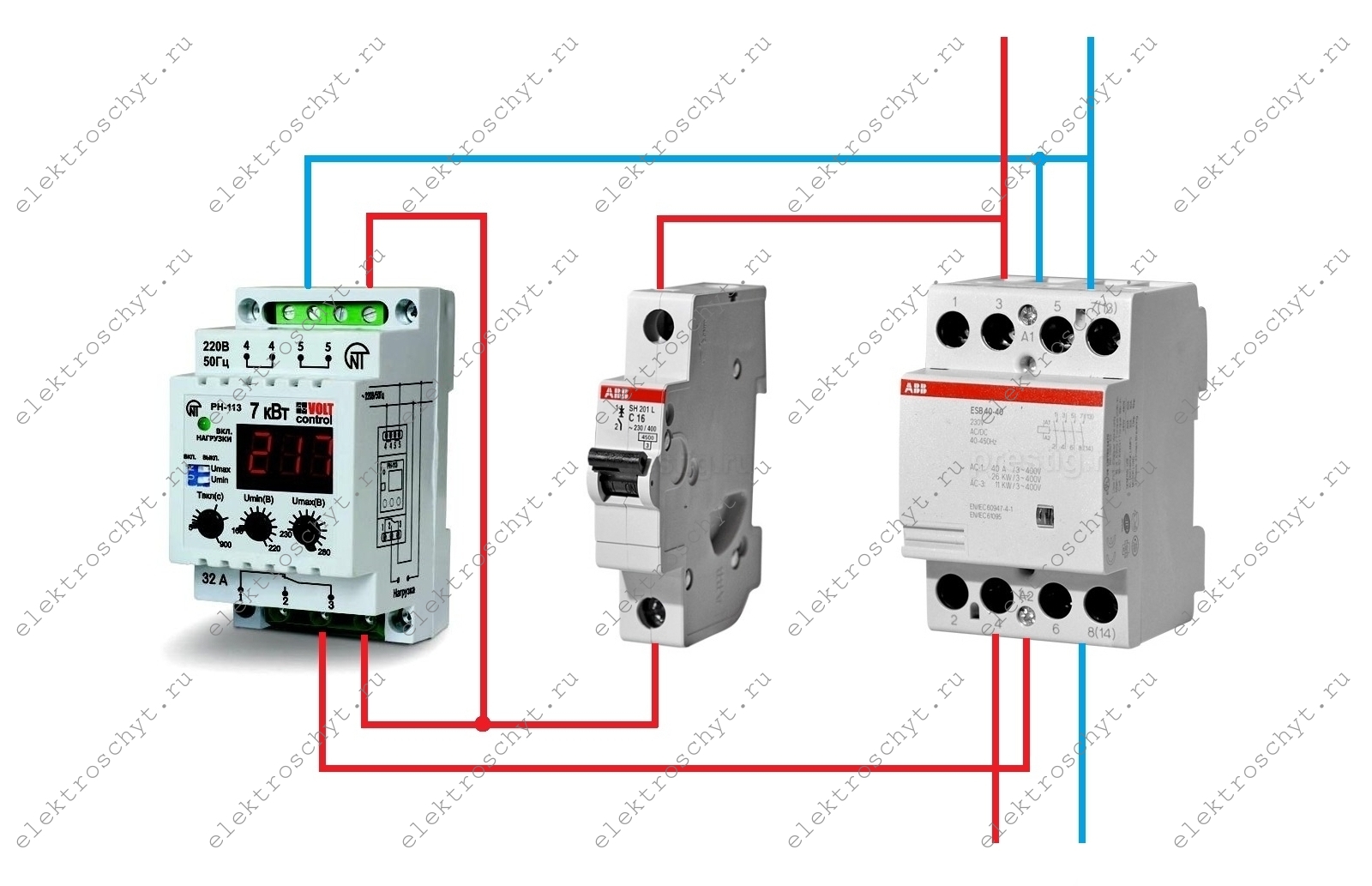
This significantly increases the cost, since a good contactor will now cost about 4-5 thousand rubles, you will need more modules in the shield, as well as an automatic machine to protect the contactor coil. The above diagram for connecting a voltage relay with a contactor for RN-111 is valid for any other relay, taking into account the features of its circuit.
The RN-113 relay is already more improved relative to the RN-111, the voltage ranges and the AR time are the same as those of the RN-111, but the maximum current for which the RN-113 can be turned on is up to 32A or if the power is up to 7 kW.
Connection diagram for voltage relay RN-113

But I would not do this, since the contacts of the RN-113 are rather weak for a wire with a cross section of 6 mm 2, and it is this section that is necessary for connecting to 32A.

It is more reliable to connect RN-113 with contactors, without contactors for a maximum of 25A. I do not use Novatek voltage relays in my shields, so I borrowed the photo from one of the electricians from the Avs1753 forum.
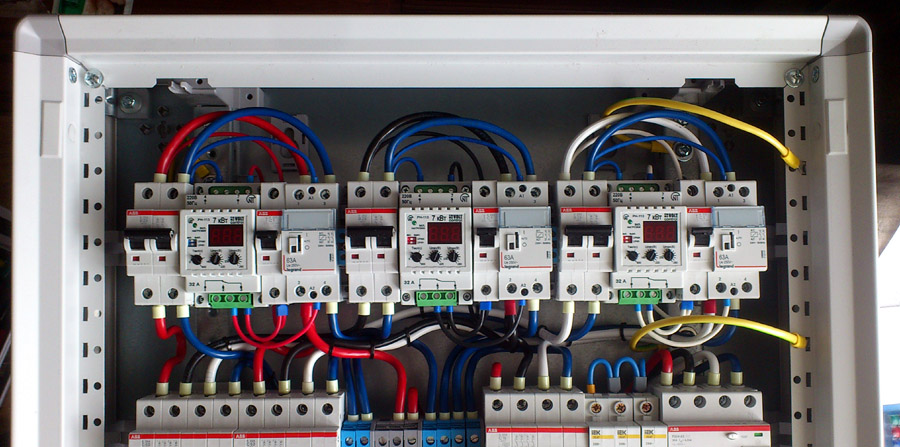
It looks, of course, beautiful, but such a connection takes 3-4 modules more and is twice as expensive in cost than if UZM-51M or Zubr were used.
But what happens with the RN-113, if you connect it without contactors at 32A.
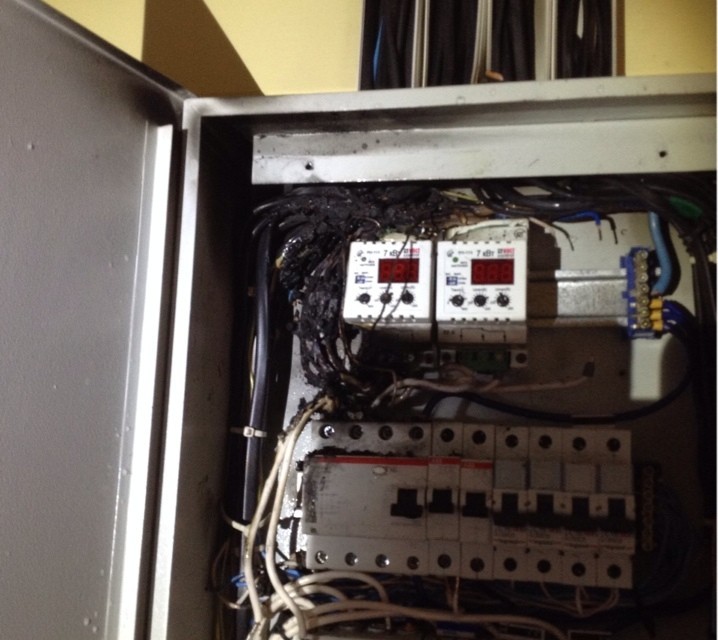
Unfortunately, I did not find any information about the tests, like the UZM-51M and the Bison, on the forums.
Voltage relay ТМ DigiTop
Just like the Zubr, these relays are produced in Donetsk. The manufacturer produces several series of devices with surge protection.
The voltage relay of the V-protektor series is intended only for protection against voltage surges. It is produced for rated currents of 16, 20, 32, 40, 50, 63 A in a single-phase version, has a built-in thermal protection against overheating, which operates at 100 degrees. The upper threshold of operation is from 210 to 270 V, the lower threshold is from 120 to 200 V. The automatic switching time is from 5 to 600 sec. There is also a three-phase voltage relay V-protektor 380, quite compact 35 mm (two modules), but the maximum current per phase is not more than 10A.
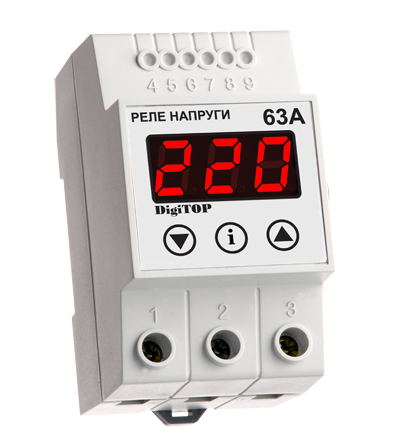
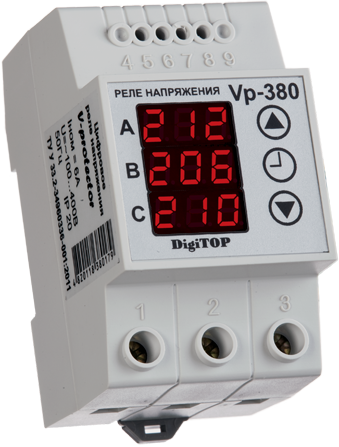
The Protektor single-phase voltage relay is guaranteed for 5 years, for the three-phase relay only 2 years.
V-Protektor DigiTop Voltage Relay Wiring Diagram
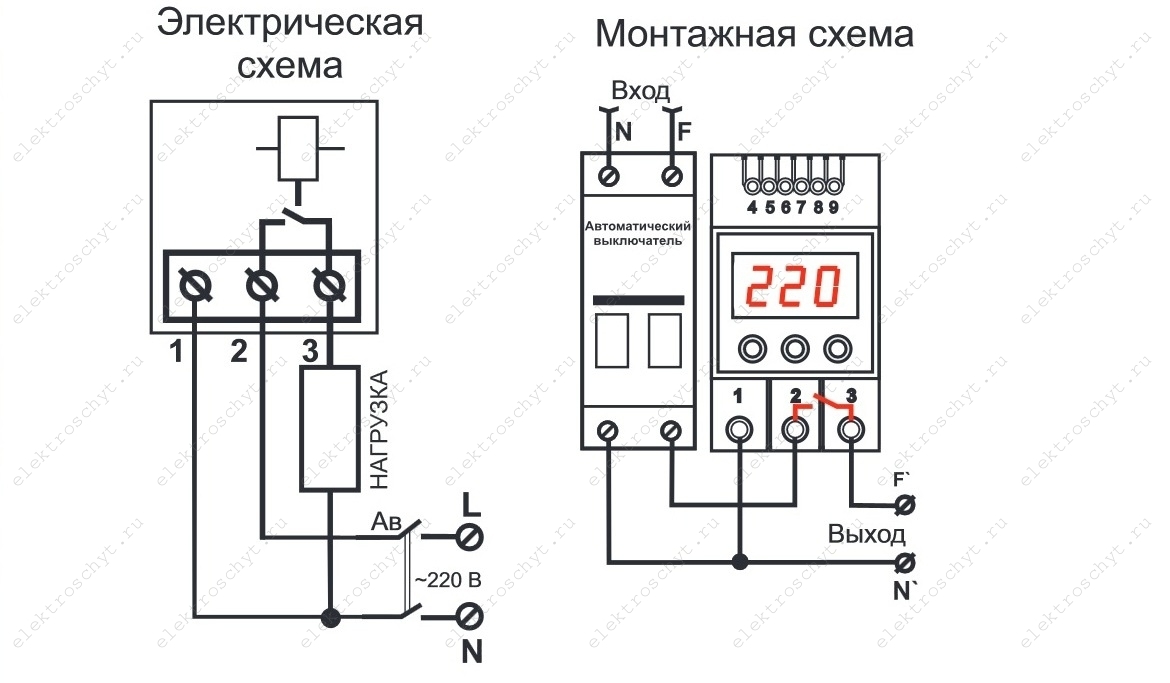
Digitop also produces a voltage relay and a current relay VA-protektor combined in one device. In addition to overvoltage protection, the device also provides current (power) limitation. They are produced for rated currents of 32, 40, 50 and 63 A. All voltage parameters are the same as for V-protektor. According to the rated and maximum current, VA controls the load and, if the rated current is exceeded, turns off the network after 10 minutes, and the maximum one - after 0.04 seconds. The instrument display shows both voltage and current. Warranty for VA-protektor 2 years.

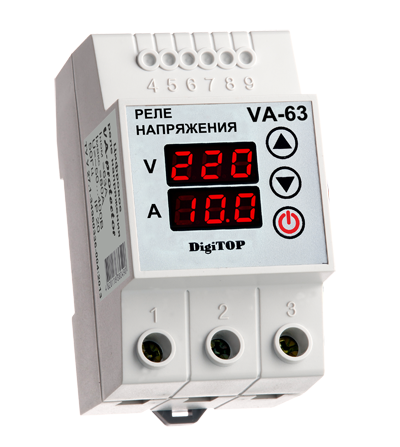
Well, the most advanced of the series of voltage relays from TM DigiTop is the MP-63 multifunctional relay. Actually, everything is the same as the previous VA-protektor, only MP-63 shows, in addition to current and voltage, also active power.
![]()
This MP-63 and V-protektor relays were independently tested by members of the forum, reviews are average.
I tried to cover in my article the most common surge protection devices. Of course, there are still manufacturers of devices for this kind of protection, but there is very little information about their application.
Thank you for your attention.
In the electrical network of a house or apartment according to GOST, the voltage should be 220 volts with a maximum deviation of no more than 10 percent. An increase in voltage of more than 242 volts is dangerous for household appliances and can lead to breakdowns and even fire. In this article, I will talk about the causes and ways to protect against power surges (surges).
Attention! Power surges can ignite electrical appliances. Do not leave household appliances turned on unattended. If you suspect an overvoltage, immediately turn off the lights, chandeliers with a switch and all sockets.
No less dangerous power surges. At which the voltage drops below the permissible minimum limit - 198 Volts, but I will talk about this in a separate article.
Signs of voltage drops in the network.

- Too often light bulbs burn out.
- Lamps incandescent or halogen lights are brighter than usual.
- periodic change intensity luminous flux of lighting.
- Appliances works unusually. The refrigerator compressor is buzzing, the washing machine is working intermittently, etc.
- Sudden shutting down and restarting the computer.
- The electronics in the house are malfunctioning.
For any suspicion in the event of power surges in your house, you need to check the voltage value with measuring instruments according to this.
Causes of voltage drops.
- Phase imbalance, which occurs due to the lack of the same load on different three . Yes, if in your apartment or private house only single phase voltage 220 Volts, then other houses or apartments are connected either to the same phase or to two other opposite ones. All lines from the substation are 3-phase. Designers try to draw up a uniform distribution scheme for all apartments or individual houses in proportion to three phases of one power line in order to avoid uneven load on all 3 phases. Therefore, phase imbalance is quite rare at home.
- Emergency operation of the power grid. Often occurs when zero breaks in storey, introductory electrical panels. In this case, all single-phase lines begin to work without a zero, which is replaced by another phase of a different name. As a result, overvoltages occur, leading to breakdowns of electrical appliances. To avoid this, it is necessary to carry out regular maintenance - check the contact and press the neutral conductor into electrical panels. Remember that without zero a 380 volt shield is the death of all your lamps and household appliances. Therefore, for private houses and garages with a 380 V input, it is mandatory and for single-phase ones it is recommended to make a ground loop, which is connected to the zero of the electrical panel. This guarantees trouble-free operation, even in the event of a zero break in the power line.
- Very rarely, power surges are caused by lightning strikes. All modern transformer substations reliably protected from surges special devices. It is only worth being afraid of residents of private houses connected to overhead power lines on poles. In my practice, there was only one case of lightning hitting a mast with an antenna in a country house. As a result, the TV burned out. Therefore, unplug the antenna during thunderstorms.
- Self-repair or incorrect connection in the electrical box. Often, young professionals or people without electrician experience, as a result of inept connection actions, supply 380 instead of 220 Volts. Or they turn on a 3-phase shield with a disconnected zero.
Keep in mind that an experienced electrician will always help determine and eliminate the cause of power surges.
MODERN PROTECTION OF HOUSEHOLD SINGLE-PHASE NETWORKS 220 V FROM HAZARDOUS VOLTAGE, ACCIDENTS IN THE ELECTRIC NETWORK AND FROM THE CONSEQUENCES OF ZERO BREAK
The power supply of most modern apartments, offices, houses and cottages begins with an apartment shield or an electricity metering panel. Typically, in addition to electric meter located in this shield, it contains start-up equipment in the form of fuses, circuit breakers, RCDs, difavtomatov.
All protective equipment, according to the PUE, is intended, first of all, to protect the external electrical network from overcurrents (short circuit currents) or overload currents, the source of which is the consumer himself. Differential protection serves to protect the consumer from the occurrence of leakage currents, as a result of which a high potential dangerous to human life can be placed on the equipment case. special protection from the voltage that is dangerous for the normal functioning of most electrical receivers, is not provided in the shields, it is a priori considered that the voltage of 220 V coming to us from the network does not go beyond the permissible norms of + 10%.
Based on this and taking into account the vast experience gained by the company in the development and production of protective devices for industrial consumers, we began to produce original protective devices for household electrical networks.
These are 1-phase voltage relay RN-111M for loads up to 3.5 kW (16 A at AC1),
relay RN-113 for loads up to 7 kW (32 A at AC1) with mounting on a standard din-rail 35 mm;
relay RN-102 for 7 kW loads (32 A at AC1) for wall mounting and
relay RN-101M plug-socket type for end-user protection up to 3.5 kW (16 A at AC1),
voltage relay RN-104, RN-106
"Volt Control" is designed to protect household appliances (equipment) (refrigerators, air conditioners, washing machines, television, video and audio equipment, etc.) up to 9 kW for RN-104 and 14 kW for RN-106 from unacceptable voltage fluctuations in the network and the consequences of a neutral break.
relay RN-116 and RN-117, - "plug-socket", plugged directly into a power outlet.
All devices are made on a modern element base, the core of the device is Atmel microcontrollers, which allow implementing complex signal processing algorithms, calculating effective voltage values, detuning from launch landings, and avoiding false positives.
Relays are distinguished by increased reliability, all elements are specially selected and adapted for domestic networks, have a high safety margin for overvoltages and operating conditions.
Relay RN-111M and RN-113 can be used for direct integration into new building housing boxes, as well as for the reconstruction of the existing power supply system,
RN-102 it can be used where the work associated with the installation and dismantling of the shield is impossible or economically unprofitable.
RN-101M is a highly effective addition to existing protection in the form of network filters, voltage stabilizers, UPS.
If the installation location of the relay is after the electric energy meter, no special installation agreement is required with energy sales companies. Now electronic meters of electric energy have become widespread, the “electronic brains” of which, like any electrical appliance, also need to be protected from surges. Therefore, after appropriate coordination with Energosbyt, the installation location of the voltage relay can be moved to the meter.
RN-101M- a universal device for protecting household appliances and electronics with a power of up to 3.5 kW.
RN-101M - from all accidents in the power grid:
- unacceptable voltage drops
- the consequences of breaking the neutral
- current overload
- network interference.
RN-101M reliably protects electrical appliances from damage by disconnecting them from the mains during power surges and current overload.
RN-101M - effectively smoothes high-frequency and high-voltage impulse noise.
RN-101 M - provides automatic switch on after voltage normalization.
RN-101M- the best protection of audio and video equipment, computer and other electronics.
The device not only provides voltage protection, but also:
Has protection on current (the current automatic device from overloads or short circuit).
A high-frequency noise filter (HF filter) that protects equipment from harmful RF interference (important for PCs, etc.).
Built-in voltmeter that allows you to view the current value of the voltage in the network.
Adjustment of time of repeated inclusion from 0-900s. All compressor units (refrigerators, air conditioners) do not provide for a sharp re-start after a power failure during their operation and require a delay of at least 3-7 minutes, otherwise they can simply burn out.
The consumer himself can set the thresholds for voltage operation using the regulators on the instrument panel.
The device can recognize a false alarm from a dangerous one for equipment. This allows you not to turn off the equipment once again, because every second there are many changes in the network.
It also provides for automatic acceleration of operation during sudden voltage surges equal to - 0.1 sec.
The RN-101M relay has overload protection - if you load more than 3.5 kW on the relay, it will turn off, the current machine will work. This is not an unimportant function, because if you include more than its switching power in the relay, this will lead to heating, burning and sticking of the relay contacts. Which, in turn, leads to heating of the case made of plastic, it can start to melt, etc. fire. In this device, this possibility is completely excluded, due to the presence of a 16A current machine.
In other words, the device simply will not pass voltage that goes beyond the limits set by the user. For example, you set 215-237V. If the voltage goes beyond these values, the relay will turn off your equipment, thereby maintaining its performance. And when the voltage returns to normal, it will automatically turn it back on. If the voltage has not returned to normal after the re-closing time, the relay will not supply voltage to the equipment.
When the load current exceeds the allowable 16 A for RN-111M or 32 A for RN-113 and RN-102, the circuit can be supplemented with miniature electromagnetic relays (contactors), for example, ESB contactors from ABB, switching currents up to 63 A.
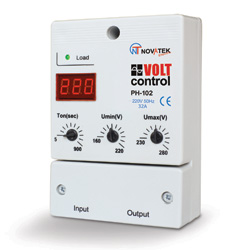
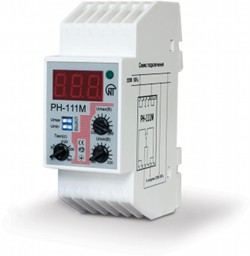


RN-113 RN-112 RN-111M RN-101M RN-117
Group apartment or floor shields can be, if desired, equipped with other protective devices: maximum current relay RMT-101, providing disconnection of the priority (non-priority) load in order to avoid the triggering of the introductory machine; power limit relay OM-110 and OM-310 to limit the consumer on the output power.
With the help of these and other relays, various schemes of energy-saving boards, ATS boards, automation and control boards can be implemented.
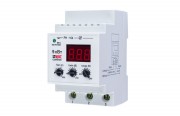
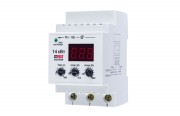
Voltage relay RN-104 (RN-106)"Volt Control" is designed to protect household appliances (equipment) (refrigerators, air conditioners, washing machines, television, video and audio equipment, etc.) with a power of up to 9 kW for RN-104 and 14 kW for RN-106 from inadmissible voltage fluctuations in the network and the consequences of a neutral break.
RN-104/106:
- provides shutdown of the protected equipment if the value of the mains voltage goes beyond the limits set by the user (after the restoration of the network parameters, automatic reclosing will occur (hereinafter AR));
- reduces the level of high-frequency interference;
- indicates the actual value of the input voltage, the state of the alarm and the state of the output relay.
RN-106 has protection against internal overheating due to prolonged excess rated current load or poor contact in the terminal connection.
Voltage relay RN-116
RN-116 indicates the effective value of the input voltage, the state of the emergency and the state of the output relay.
The single-phase voltage relay RN-116 has all the functions of the voltage relay RN-101M.
Voltage relay RN-117 designed to turn off household and industrial 1-phase loads 220 V, 50 Hz with a power of up to 3.5 kW (up to 16 A) in case of unacceptable voltage fluctuations in the network with automatic reclosing (hereinafter AR) after restoring the network parameters.
RN-117 indicates the compliance of the electrical network voltage with the current standards, the state of the emergency and the state of the output relay.
The single-phase voltage relay RN-117 has all the functions of the voltage relay RN-101M.
UZM-50, UZM-51M
Purpose UZM-50, UZM-51
Single-phase protection device UZM-51M, UZM-50M designed to protect the electrical equipment of TVs, refrigerators, etc. connected to it in apartments, cottages, electrical equipment of cottages, office premises from power surges, to turn off the equipment when the mains voltage goes beyond the permissible limits, in the event of a break in the neutral wire, improper connection ( instead of zero and phase connected to two phases) and automatic connection of equipment when the voltage is restored.
If it is necessary to protect the electrical equipment of the connected to three-phase network, three protective devices are installed for protection, one in each phase.
UZM-50M differs from UZM-51M in the absence of threshold adjustment, in UZM-50M the thresholds are fixed.
Specifications, surge protection device UZM-51M, UZM-50M
| Supply voltage, it is also controlled | AC 160-280V |
| Rated switching current | 63 A |
| Maximum switching current | 80 A (30 min) |
| Setting the upper trip threshold tripping delay: at voltage > 300V | 230 V to 280 V in 5V increments for UZM-50M 265V 0.2 s 20 ms |
| Setting the lower trip threshold Trip delay: at voltage< 130В | from 210 to 160 V in steps of 5V for UZM-50M 170V 10 s 100 ms |
| Built-in varistor protection against power surges | Yes |
| Max. shunt current by varistor | 8000 A |
| Ensuring Pulse Suppression | 8/20µs with energy up to 200 J |
| Fixed programmable reclosing delay (user selectable) | 10 seconds or 6 minutes |
| Maintains performance over a wide range of supply voltages | 0...440 V |
| Possibility of manual control | Yes |
| Can be used in networks | TN-C, TN-S, TN-C-S, TT |
| Overall dimensions, mm | 83x35x67 |
| Operation of the device from increased voltage UZM-50M, UZM-51M
At voltage supply power supply, the device maintains a standby time of 10 seconds, while the indication does not work, and then the green indicator starts flashing, indicating the countdown of the turn-on time delay t1. If the voltage is within acceptable limits, the load is connected to the supply voltage network and the green and yellow indicators light up. It is possible to accelerate the connection of the load manually by pressing the "TEST" button. |
|
Multifunctional protection device UZM-51M
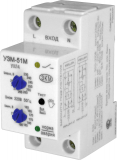
Multifunctional protection device UZM-51M is designed to protect the equipment connected to it from the damaging effects of powerful pulse voltage surges caused by electromagnetic pulses of nearby lightning discharges or the operation of nearby electric motors, magnetic starters or electromagnets connected to the same network, as well as to turn off the equipment when the mains voltage goes beyond the permissible limits (<170 В или >265 V) in single-phase networks, thereby preventing equipment failure and possible ignition with subsequent fire.
Device UZM-51M are voltage control relays with a powerful electromagnetic relay at the output, supplemented with energy-intensive varistor protection. Switching on after power supply or after an emergency shutdown occurs automatically after 10 seconds when the mains voltage is restored to normal. Application in networks of any configuration is possible; TN-C, TN-S, TN-C-S, TT. Does not replace other protection devices (circuit breakers, RCDs, etc.).
Specifications: The protection device UZM-51 M is manufactured in a plastic case with DIN rail mounting, in which an electronic voltage relay with adjustable thresholds is mounted, made on the basis of a microcontroller, which has a polarized electromagnetic relay with powerful contacts at the output.
!!! Does not replace other protection devices (circuit breakers, RCDs, etc.).
Main parameters of UZM-51M:
Load protection against power surges
Max. shunting current of pulses by varistor - 8000 A
Provides suppression of pulses with energies up to 200 J
Overvoltage load protection (242-286V)
Load protection against undervoltage(154-198 V)
Fixed response delay - 0.2s when overvoltage
10s undervoltage
Upper fast shutdown threshold (< 20мс) при превышении напряжения >300V
Low Fast Shutdown Threshold (100ms) Under Voltage<130В
Rated switching current 63A
Keeps working capacity in a wide range of supply voltage - up to 440 V
Purpose of UZM-51M
Multifunctional protection device USM is designed to protect the equipment connected to it (in an apartment, office, etc.) from the damaging effects of powerful pulsed voltage surges caused by electromagnetic impulses of close lightning discharges or the operation of nearby electric motors, magnetic starters or electromagnets connected to the same network, as well as for shutdown of equipment when the mains voltage goes beyond the permissible limits (170 - 270V) in single-phase networks. The equipment is switched on automatically when the mains voltage is restored to normal, after the restart delay has elapsed.
To protect residential electrical equipment from overvoltage or undervoltage
in the input apartment panel (immediately after the meter), we suggest installing a voltage control device with an overvoltage threshold of 250 ... 270V and a voltage drop threshold of 160 ... 170V, with a response time of not more than 0.5 s and with automatic return when the voltage is restored with a delay of 1 ..3 minutes. The permissible current of the device contacts must be at least the maximum current consumption of a modern apartment - 25 ... 40A (5.5 ... 8.8 kW).
How to protect an apartment from overvoltages, zero breaks, phase reversal and zero, and so on?
Experts recommend installing an UZM, which protects both from impulse noise and from overvoltage, undervoltage.
When asked how to protect a country house (cottage) from overvoltages, zero breaks, phase reversal and zero, in the case of a three-phase voltage supply, experts also recommend installing an UZM on each phase, since when one of the phases is turned off, the remaining consumers remain on.

Work UZM-51M
When the supply voltage is applied, the green LED turns on. If the voltage is within acceptable limits, the load is turned on with a delay of 6 minutes or 10 seconds, the output relay is activated and the yellow LED lights up. Fast manual activation is possible before the expiration of the six-minute delay (if the mains voltage is within acceptable limits). During operation, if the voltage is out of range, the load is automatically disconnected. When the voltage is restored to normal, the UZM automatically turns on with a delay of 6 minutes or 10 seconds.
When the voltage in the network rises above 270V, the UZM turns off the relay with a delay of 0.2 s, when the voltage in the network rises above 300V, an accelerated shutdown occurs<20мс. В случае понижения сети менее 170В УЗМ отключает нагрузку с задержкой 10с, а при понижении напряжения менее 130В происходит ускоренное отключение <100мс.
In the normal mode of operation (the relay is on), when the "TEST" button is pressed, the device disconnects the load, which indicates the normal functioning of the device.
The "TEST" button of manual control allows you to turn on the power to the load without waiting for the end of the turn-on delay time, or turn it off if you want to de-energize the consumers.
When powerful voltage pulses appear in the network, the built-in varistor shunts them to a safe value for the equipment.
Information
:
- a fixed turn-on (re-start) delay of 6 minutes is chosen to protect refrigerators, air conditioners and similar equipment. it is recommended to apply voltage to compressors (installed in such products) with a delay of 5-6 minutes from the moment the voltage is turned off;
- a powerful polarized relay (has two stable states) is installed in the UZM-51, which is not under constant voltage, and voltage is applied to the electromagnetic relay winding at the moment of switching. consumption, internal heating is reduced and the reliability of the device is increased.
The device is designed for installation in apartment panels of residential buildings or introductory cabinets in offices, workshops, etc. and is made in a modular design with a 35mm standard DIN rail mount, which allows it to be installed in any electrical cabinet. The body of the device is made of plastic that does not support combustion, which completely eliminates spontaneous combustion in the event of the destruction of the built-in varistor from a powerful current surge. There is a button "TEST" on the front panel of the device to check the product's operability. The reliability of the device is ensured by the use of a high-speed bistable relay specially designed for it with contacts for a current of 80A, a large margin for the parameters of all electronic components, low power consumption (<5мА) и большим запасом по напряжению питания (440В).
Advantages of the RBUZ voltage relay (ZUBR):
most models have a thermal protection function (protection against overheating);
a wide assortment range: on a din-rail (from 16A to 63A), in a socket (for 1, 2, 3 and 6 sockets), for three-phase networks);
the body is made of self-extinguishing polycarbonate (does not support combustion);
reliable and powerful crimp terminals (as on automatic machines);
remembering the last maximum and minimum emergency voltage;
5 year warranty.
Whole house voltage relay Whole house surge protection
RBUZ D25, RBUZ D25t, 25 A (max. 30 A), 5500 VA
RBUZ D32, RBUZ D32t, 32 A (max. 40 A), 7000 VA
RBUZ D40, RBUZ D40t, 40 A (max. 50 A), 8800 VA
RBUZ D50, RBUZ D50t, 50 A (Max. 60 A), 11,000 VA
RBUZ D63, RBUZ D63t, 63 A (max. 80 A), 13,900 VA
Voltage relay in socket, household surge protection
RBUZ R116y, RBUZ R216y, RBUZ P316y, RBUZ P616y, 16 A, 3000 VA
Voltage relay for three-phase load, protection of three-phase load RBUZ 3F, 5 A, 1000 VA
Voltage relay for contactor control RBUZ D16, 16 A, 3500 VA
DIGITOP
Relayvoltage Vp-10AS, Vp-16AS, Vp-16A DIN, Vp-20A DIN, Vp-32A DIN, Vp-40A, Vp-50A, Vp-63A,
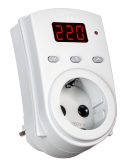
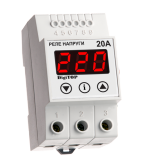

VA-32A, VA-40A, VA-50A, VA-63A,
Vp-380A DIN (3-phase, phase), MP-63A
LLC "SAVEL" offers protection of household appliances and single-phase networks from power surges and other equipment
